Roses are one of the most popular and famous ornamental flowering plants. They began to be cultivated since the times of Ancient Rome; today several hundred species and varieties are known. Among all varieties, bush roses intended for growing in a garden or greenhouse have become widespread.
They are used for landscaping areas, flower beds and urban plantings. This is the largest group of roses, which includes flowers of various shapes, colors and heights. In the article you will find the most famous varieties of bush roses, their descriptions and photos.
general characteristics
All bush roses were bred from rose hips through selection with other cultivated varieties. Thanks to this, it was possible to achieve a wide range of colors and plant shapes. Depending on the type, bush roses form a bush with a height of 25 cm to 2 m. All shades and colors of the petals are displayed, except blue. There is a huge variety of shapes and structures of buds. Shrub roses have become widespread due to the following characteristics:
- a wide range of colors and shapes of petals;
- long flowering;
- unpretentiousness to climate;
- pleasant aroma during flowering;
- variability of use in landscape design.
Shrub roses can be grown from cuttings, by dividing the bush and by seed, so there are no problems in forming a large planting or even a hedge. Roses for gardening began to be actively cultivated during Victorian London, but species and varieties were also developed in other countries.
Caring for bush roses in the garden
In order for plants to enjoy lush flowering all season long, it is necessary to provide them with proper care. The set of activities includes:
- Regular loosening of the top layer of soil, which helps maintain moisture and ensure the bushes develop properly. As autumn approaches, the operation is performed less frequently.
- Watering - intensive during growth and appearance of buds - is carried out in the morning. Make it in the root hole of the plant. Before winter, to prevent new shoots from appearing, stop watering.
Caring for bush roses in the garden requires mandatory feeding. In this case, you need to take into account:
- Fertilize for the first time when the leaves appear on the plant;
- during the flowering period, feed every two weeks;
- in August, plants are fertilized to prepare for winter;
- It is not recommended to use fresh manure - the bushes may be damaged;
- Fertilizers must be applied to the soil under the plant and then watered.
How to plant a rose from a bush
One of the simplest ways to do it in the spring is to divide the bush. The plant is dug up until the buds have blossomed and separated into parts with pruning shears, each with shoots and roots. To propagate climbing roses, layering is used. The operation is performed like this:
- take a two-year escape;
- make circular cuts on it - places where roots will appear later;
- dig a ditch;
- lay the shoot, pin it;
- watered, covered with soil;
- the upper part of the shoot is tied vertically;
- next spring separate from the bush;
- transplanted.
You can plant a rose from a bush by cuttings. For this:
- choose a strong flowering shoot;
- cut off the top;
- cuttings are made from the middle part, in which there are 2-3 internodes and leaves;
- planted in a greenhouse obliquely, shaded from the sun, maintaining humidity;
- the buds that appear are removed;
- for the winter they are transplanted into pots;
- stored in the basement;
- planted in spring.
Pruning a bush rose
One of the important requirements when caring for plants is regular and proper pruning. The first is done in the spring, in April, when it is clear how the bush endured the cold. Poorly overwintered stems and branches affected by diseases are removed. Pruning a bush rose is necessary for:
- strengthening the plant;
- increasing the number of new shoots;
- lush blossoming of buds;
- lengthening the flowering period.
In summer, faded buds are removed so that new ovaries appear. In the fall, the bushes are thinned out and diseased branches are cut out. To carry out the work, you must follow the rules:
- sharpen the instrument well and disinfect it;
- cut shoots above the buds;
- remove dry, old, diseased and weak branches;
- remove branches that cross or grow inward;
- make the cut obliquely.

- How to starch a dress at home correctly
- How to remove fleas from a cat
- How to present yourself at a competition
Preparing bush roses for winter
Activities must be started in advance so that the plants can withstand the cold well. Preparing bush roses for winter begins at the end of summer. Necessary:
- in August, limit watering to prevent new shoots from growing;
- feed the plants with phosphorus and potassium - strengthen them, prepare them for wintering;
- September - remove leaves from below, cut out diseased branches;
- in mid-October - remove all foliage from bushes and soil;
- select materials for shelter;
- preserve rose bushes.
How to cover bush roses for the winter
The easiest way to cover for the winter is to hill up the bush after pruning to form a mound of 25 cm; you can additionally put spruce branches on top. A dry air shelter reliably protects the shrub in frosty weather. There is no need to do it until the temperature drops below minus 8 degrees. To implement:
- the plant is pruned or pinned to the ground;
- they put pegs around;
- a wooden shield is placed on top of them;
- everything is covered with film - one edge is left slightly open for ventilation;
- the covering is fixed with a weight.
How to cover bush roses for the winter if they have long stems that cannot be pruned, for example, climbing ones? It is important not to wait for frost so that the stems can be bent without breaking. For shelter you need:
- dig up the soil around the stem;
- carefully remove the branches from the support;
- carefully, so as not to break it, bend it to the ground;
- place on prepared spruce branches;
- pin to the ground with rods;
- Cover the top with spruce branches and film.
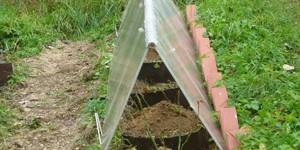
Park
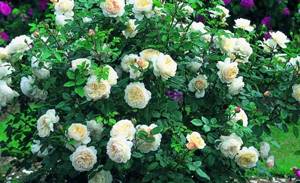
This is a large group of unpretentious plants used for landscaping gardens and city parks. The bush lends itself well to shaping, so it can be given almost any shape. The average height of the plant is 1.5 m, but dwarf varieties are also known. Flowering is early and very abundant.
The color of the petals comes in a wide variety of shades. Park roses have high frost resistance and are suitable for growing in the north. Several hundred varieties are known, which are usually divided into two large groups - English and Canadian.
English roses
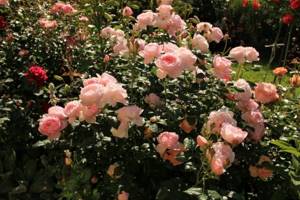
Brought out around the end of the 20th century. In Europe they are often called ostinki in honor of their creator. According to the classification of roses, they are classified as a standard type, since the plant combines the features of a shrub and a traditional flower. The plant reaches medium height, the flowers are usually double. The main disadvantage of English roses is increased sensitivity to humidity and poor resistance to disease. Famous varieties of English roses:
- Abraham Derby . The variety is represented by a flower with a classic bud shape. The color of the petals varies from dark yellow to pale apricot. Can be grown as a climbing plant. The plant has a high growth vigor, but the shoots can lie down due to the weight of the buds;
- Benjamin Britten . The bush can reach a height of up to 1 meter. In young plants, the bud is cup-shaped, then it can become rosette-shaped. The petals are colored red-orange. The variety has high resistance to powdery mildew;
- William Shakespeare 200 . A hybrid variety represented by an erect bush. The flowers are dark red in color and have a cup-shaped bud. As they grow, their color may turn purple. The variety has a very long flowering period;
- Charlotte . A shrub variety of English rose, reaches heights of up to 50 cm. The flowers are double in structure, the petals are painted in a pale yellow tint. The rose has high winter hardiness;
- William Morris . A variety of climbing varieties of park roses. The flowers are formed in the form of rosettes and are painted in a delicate pink-peach color. Unlike other varieties, it tolerates high humidity.
Almost all varieties of English park roses are combined in the shape of the buds, their color and leaf blades. This allows you to grow several varieties in one area.
Canadian roses
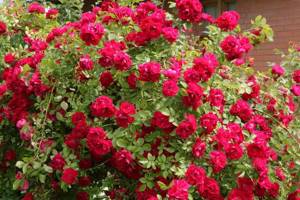
This large group of varietal roses is characterized by increased winter hardiness. Plants are not afraid of temperature changes, and leaves are easily restored after frost. The shrubs are quite large; during flowering they are completely covered with buds of different colors depending on the species. The most interesting varieties:
- Morden Sunrise . The variety was developed in 1999 and is considered the first yellow Canadian rose. The shrub grows up to 70 cm in width, the buds are large and reach an average diameter. When growing, shelter for the winter is not required;
- Morden Blush . A profusely flowering variety of Canadian rose. The erect bush grows up to 75 cm. Externally, the plant is very similar to a hybrid tea rose. Terry petals are pink and white. Has low resistance to black spot;
- Cuthbert Grant . One of the few scrub varieties of Canadian roses. The bush will grow up to 1.2 m in height. The leaves are painted a rich green color and are very decorative. The flowers are red. Gardeners note the variety’s very high resistance to diseases and pests;
- Champlain . The rose of this variety is represented by a bush of medium vigor. Flowering is observed almost all summer until the first snow. Small double flowers abundantly cover the plant and are colored red. Has poor resistance to powdery mildew.
Canadian roses are considered the most suitable variety of shrub group for growing in Russia. They have high frost resistance and rarely become infected. Ways to get along in almost any environment.
Rules for propagating red roses
There is more than one way to propagate red roses.
Cuttings.
To do this, you need to cut off a shoot that will have several buds. The stem should be at least half woody, or better yet completely. Then soak the lower part of the shoot in a growth stimulator for one day. After this you can plant it. It is necessary to create greenhouse conditions for your seedlings by covering them with polyethylene. Over time, your cuttings will begin to form a root system, and next year it will be possible to transplant your young plant to a permanent habitat.
With the help of layering.
This method is especially suitable for propagating roses that do not have short stems. Prepare the hole in advance; it should not be very deep. You need to put a shoot bent to the ground into it. Secure it with wire and cover it with soil. Next season it will be possible to cut cuttings from the main bush and plant them in the required area.
Polyanthaceae
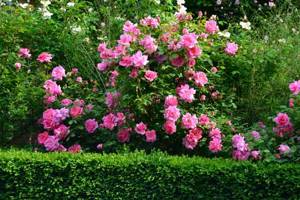
They were developed in France in 1873. These are multi-flowered roses, which according to modern classification are classified as bush roses. The plant is usually short (40-60 cm), but is distinguished by very dense foliage and small flowers. During flowering, they completely cover the plant; up to 50 flowers can form on one inflorescence.
They have high rates of frost resistance and vitality. Most varieties are resistant to fungal infections. Polyantha roses are easy to grow from seeds; in adulthood, the shrub is not afraid of shade and drought. The flowers are suitable for garden decoration or use in bouquets. Popular varieties:
- The Snow Queen . Cultivated since 1901. The height of the bush reaches 1 m, the shoots grow straight. The buds are initially pinkish in color and become bright white as they bloom. The flowers are odorless. The main disadvantage of the variety is low resistance to powdery mildew;
- Alfred Colomb . The variety is represented by a vigorous bush, on which large double buds are formed in large numbers during flowering. The flowers are strawberry-colored;
- Goldstein . The branched bush reaches 80 cm in height. The leaves are very large and leathery. During flowering, cup-shaped buds cover the entire bush and exude a pleasant aroma. The petals are painted in a dark crimson hue.
The modern division of all garden roses was approved only in 1976. Due to their similarity with hybrid tea varieties, some polyanthus varieties may simultaneously belong to two groups.
How to grow a red rose correctly
Red roses are quite demanding in terms of temperature; they love warmth. Therefore, the area where you plan to grow red roses should be in a sunny place. There must also be protection from winds. The groundwater level should not be too close to your plantings. Loam, which will contain a sufficient amount of organic matter, is best suited for red roses.
Red roses are usually planted in open areas in spring or autumn. The planting hole should reach sixty centimeters in size. A good drainage layer needs to be laid at the bottom. Expanded clay or small pebbles are good for this.
Before planting red roses, prune the roots a little. Be sure to save the small roots! The stems also need to be shortened to ten to fifteen centimeters. Each shoot must have buds. Remove weakened stems.
When planting, it is necessary to maintain a distance of half a meter to one and a half between plants. It all depends on the chosen rose variety. When planting rhizomes, the plants should not dry out. To prevent this from happening, dip the root system in cow dung and clay. The mixture is in a ratio of one to two.

Floribunda
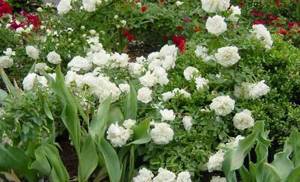
This group was officially included in the classification of roses in 1976. They occupy an intermediate position between hybrid tea varieties and polyanthus roses, since they have common features of both types. The group includes both tall and dwarf border shrubs.
They have a large number of petal colors and are significantly superior to hybrid tea varieties in color saturation. They are distinguished by high frost resistance and disease resistance. Used for cutting. Popular varieties of floribunda roses:
- Rosemary Rose . Cultivated since 1954. The bush has a high growth vigor, reaching 80 cm in height and 70 cm in width. Double flowers grow up to 8 cm in diameter, the petals are painted in a rich pink hue. There is resistance to fungal diseases;
- Bella Rosa . The bush is compact and rather loose, grows up to 60 cm. The cup-shaped buds have pronounced terry and a pleasant aroma. Capable of blooming all summer. Petals are red. When grown in central Russia, it is necessary to provide shelter for the winter;
- Anthony Meilland. One of the most decorative varieties of floribunda roses. The bush can grow up to 1 meter. The buds are goblet-shaped or cup-shaped, the average diameter is 8 cm. The petals are a rich yellow shade, practically do not fade in the sun;
- Anabell . Compact rose with early flowering period. The buds can change their shape during the season and grow up to 10 cm in diameter. The flowers are bright orange with a silver tint. After flowering, the petals curl down;
- Nina Weibull . Danish variety, bred in 1962. The bush grows up to 75 cm in height, the width reaches 50 cm. The terry buds are painted in a rich red color. In one season you can achieve flowering up to two times.
Floribunda roses are often called profusely blooming, which is a direct translation of the name. Flowers are suitable for both single and group plantings. Combines well with other shrubs.
Hybrid tea
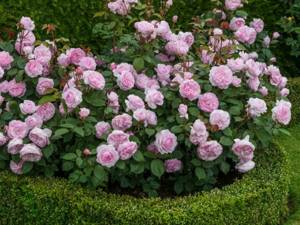
It is believed that this group of garden roses was bred from the LaFrance variety, obtained in 1867 by the breeder Guillot. He used remontant and classic tea roses as mother plants; as a result, all varieties vaguely resemble these varieties. All varieties of hybrid tea roses differ in height and shape of the bush, but have a pleasant aroma and a long flowering time. Common varieties:
- Peer Gynt . An early rose variety that is prone to powdery mildew. The bush reaches a height of up to 90 cm and forms lush foliage. The flowers are golden yellow with a soft pink border. It is considered a standard crop and is used to create bouquets;
- Alexander . An erect variety, it can grow up to 1.5 m in height. Semi-double flowers are painted in a rich red color, their diameter can reach 12 cm. Used for bouquet arrangements and creating hedges;
- Prima ballerina . Flowerbed variety of hybrid tea roses. An erect bush does not exceed 1 m in height. The flowers are semi-double, painted in a pleasant cherry shade. The buds have a classic shape, very large. Has weak immunity to powdery mildew;
- Dame de Kerr . Frost-resistant and resilient rose variety. The height of the bush does not exceed 90 cm, suitable for growing in group plantings. Large double flowers are red-crimson in color; their diameter can reach 12 cm. The buds are cup-shaped or cone-shaped;
- Lucky Peace . This variety has gained particular popularity due to the ideal shape of the buds. Some gardeners consider the flowers of this variety to be the perfection among all garden roses. They have a delicate color, orange-red below, with a pink-apricot coating on top. The bush is compact, does not exceed 80 cm. The buds reach a diameter of up to 10 cm, collected from 50 petals.
It is hybrid tea roses that are most often grown to create bouquets because of their delicate pastel colors and pleasant aroma of flowers. The development of new varieties continues to this day.
Grandiflora
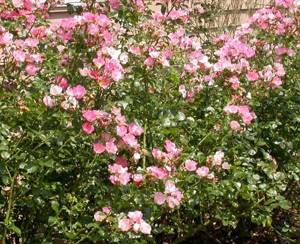
One of the youngest groups of garden bush roses, grown in the 50s of the last century by crossing hybrid tea varieties with floribunda. The bushes are distinguished by their strong structure and can reach a height of up to 200 cm. The flowers are shaped like a hybrid tea rose, but have a more lush structure.
They are used for decorative landscaping and look beautiful both in single and group plantings. They have high immunity to diseases, some varieties are frost-resistant. The most popular varieties:
- Stella . The bush is erect, forms long shoots with large thorns. The buds reach a diameter of up to 12 cm, collected from 30-40 petals. The flowers are peachy-pink in color and emit a pleasant aroma during flowering. Suitable for growing as a standard crop and cutting;
- Sonya . It is represented by an erect shrub up to 80 cm in height. The buds are collected in small brushes of 3-5 pieces. The flowers are colored coral and have a fragrant scent. Flowering is very long, suitable for creating bouquets;
- Love . A vigorous plant that grows up to 80 cm. It is used for group and single plantings. The flowering is unnatural for this group of roses - the petals are red on the inside and covered with a silvery-white coating on the outside. The buds are goblet-shaped and reach 13 cm in diameter. The variety is frost-resistant and can withstand darkening;
- Komsomolsky Ogonyok . A shrub variety of rose, grows up to 120 cm in height. The shoots are erect and have large matte leaves. The cup-shaped buds reach 13 cm in diameter, collected from 20-25 red petals with a golden tint inside. It has high frost resistance and is suitable for group planting.
According to the modern classification of roses, there are more than 30 groups of these plants. They are combined by the height of the bush, the shape and structure of the buds and the specifics of cultivation. Shrub roses are considered one of the most popular varieties of this crop. You can use them to decorate an area or a flower bed; the flowers also look decorative when cut. When choosing a variety, you should take into account stability, frost resistance, appearance and characteristics of the formation of the bush.
Purple Munstead Wood
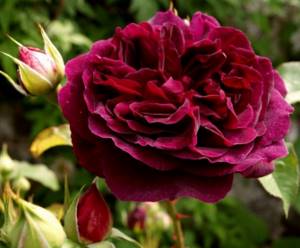
The English rose "Munstead Wood" has a medium-sized bush, reaching a height of about 1 meter. The width of the bush is 60 cm, but with good care and favorable conditions it becomes branched and dense.
Young foliage is painted in a red-bronze hue, which creates a beautiful contrast with the buds, which are light crimson in color. When the flower opens, its center becomes darker and takes on a velvety burgundy hue, while the outer petals remain lighter.
A densely double rose has up to 70 petals in a bud. Large flowers at the beginning of flowering are formed into a neat cup, and over time they become more spreading and yellow stamens appear in the center.
The buds are large - up to 12 cm in diameter. They exude the rich aroma of classic rose oil with a fruity note. The variety has good immunity and resistance to diseases and frost.











